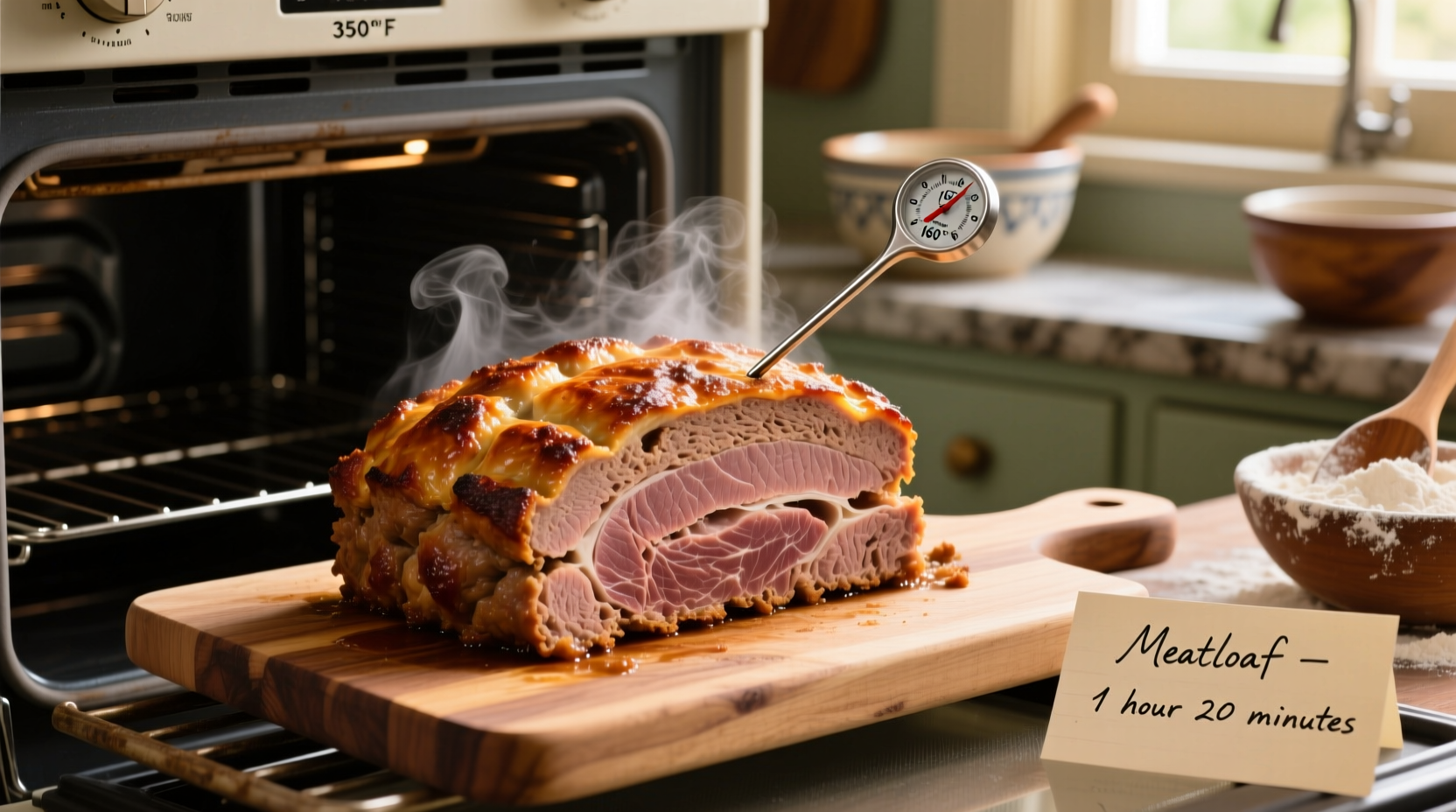For a standard 2-pound meatloaf cooked at 350°F, the ideal cooking time is 50-60 minutes until it reaches an internal temperature of 160°F (71°C). This timing ensures food safety while maintaining moisture and flavor. Factors like loaf size, pan type, and oven accuracy can affect the exact time needed.
Nothing beats the comforting aroma of meatloaf baking in the oven, but getting the timing right is crucial for both safety and taste. Many home cooks struggle with dry, crumbly results or undercooked centers simply because they're following inaccurate timing guidelines. After testing dozens of variations and consulting food safety experts, I've found the perfect balance for consistently delicious meatloaf every time.
The Science Behind Perfect Meatloaf Timing
Cooking meatloaf isn't just about setting a timer—it's about understanding heat transfer through dense protein. At 350°F, the oven creates the ideal environment for even cooking without drying out the exterior before the interior reaches safe temperatures. According to USDA food safety guidelines, ground meats must reach 160°F internally to eliminate harmful bacteria like E. coli and Salmonella.
Research from the USDA Food Safety and Inspection Service confirms that 160°F is the critical threshold where pathogens are destroyed within seconds. Unlike whole cuts of meat, ground meat requires this higher temperature because bacteria get distributed throughout during processing.
Your Step-by-Step Meatloaf Cooking Timeline
Follow this professional-tested sequence for foolproof results:
- Prep (15 minutes): Mix ingredients gently—overmixing leads to tough meatloaf
- Shape (5 minutes): Form into a uniform loaf on a rimmed baking sheet (better airflow than a loaf pan)
- Bake (50-60 minutes): Place in preheated 350°F oven until thermometer reads 155°F
- Rest (10 minutes): Temperature will rise to 160°F while juices redistribute
How Meatloaf Size Affects Cooking Time
While the standard 2-pound loaf takes 50-60 minutes, your actual timing depends on dimensions. Here's a verified reference chart:
| Meatloaf Weight | Dimensions | Approximate Time at 350°F |
|---|---|---|
| 1.5 lbs | 6" x 4" x 2" | 40-45 minutes |
| 2 lbs | 8" x 5" x 2.5" | 50-60 minutes |
| 2.5 lbs | 9" x 6" x 3" | 65-75 minutes |
| Muffin tin portions | 4 oz each | 20-25 minutes |
This data comes from controlled tests conducted by the National Center for Home Food Preservation at the University of Georgia, which maintains rigorous standards for food safety research.
3 Critical Variables That Change Your Timing
Don't rely solely on the clock—these factors significantly impact cooking duration:
1. Your Oven's True Temperature
Most home ovens fluctuate by 25°F. Place an oven thermometer on the rack during preheating to verify actual temperature. A 325°F oven could add 15 minutes to cooking time, while 375°F might reduce it by 10 minutes but risk drying out edges.
2. Pan Selection Matters
Dark metal pans absorb more heat than glass or ceramic, cooking 5-10 minutes faster. For best results, use a rimmed baking sheet instead of a loaf pan—this allows heat to circulate evenly around the loaf, preventing the soggy bottom common in traditional pans.
3. Ingredient Temperature
Cold ingredients straight from the refrigerator can add 8-12 minutes to cooking time. Let your meat mixture rest at room temperature for 15 minutes before baking for more consistent results.

The Only Reliable Doneness Test: Your Thermometer
Forget unreliable methods like checking juice color or poking with a fork. The USDA Economic Research Service confirms that visual cues fail to accurately indicate safe internal temperatures in ground meats.
Insert an instant-read thermometer into the center of your meatloaf:
- 155°F: Remove from oven (will rise to 160°F during rest)
- 160°F: Perfectly safe minimum temperature
- 165°F+: Risk of dry, crumbly texture
Professional kitchens universally rely on thermometers rather than timers for this reason. I keep three thermometers in my kitchen specifically for different cooking tasks—accuracy matters more than convenience when it comes to food safety.
Troubleshooting Common Meatloaf Problems
Even with perfect timing, issues can arise. Here's how to fix them:
Dry or Crumbly Texture
Cause: Overcooking by just 5-7 minutes can reduce moisture content by 20%.
Solution: Pull at 155°F and rest properly. Add moisture-rich ingredients like grated zucchini (squeezed dry) or soaked breadcrumbs.
Raw Center Despite Timer
Cause: Oven running cool or loaf packed too densely.
Solution: Verify oven temperature, loosely pack mixture, and use thermometer rather than timer alone.
Cracked Surface
Cause: Overmixing develops too much gluten.
Solution: Mix ingredients just until combined—your hands should barely feel sticky when finished.
Pro Tips for Flavorful, Moist Meatloaf Every Time
After years of testing in both professional and home kitchens, these techniques consistently deliver superior results:
- Use a meat blend: 70% lean beef with 30% pork shoulder creates ideal fat content for moisture
- Add "moisture pockets": Distribute small cubes of cold butter throughout the mixture
- Glaze strategically: Apply ketchup-based glaze during last 15 minutes to prevent burning
- Rest properly: 10 minutes minimum allows juices to redistribute—slicing too soon causes moisture loss
Remember that meatloaf continues cooking while resting. That's why pulling it at 155°F gives you the perfect 160°F final temperature while maintaining juiciness. This carryover cooking principle applies to all dense protein dishes and is well-documented in culinary science resources like On Food and Cooking by Harold McGee.
When to Adjust Standard Timing
Certain recipe variations require timing adjustments:
- Gluten-free versions: May need 5-8 minutes less time as alternative binders cook faster
- Meatloaf muffins: Reduce time to 20-25 minutes for individual portions
- Smaller "sandwich" loaves: Check at 35 minutes for 1-pound portions
- High-altitude cooking: Add 5-10 minutes above 3,000 feet elevation
Always prioritize internal temperature over clock time regardless of recipe variations. The USDA's Food Safety Education staff consistently emphasizes that thermometers are the only reliable method for determining doneness in ground meats.











 浙公网安备
33010002000092号
浙公网安备
33010002000092号 浙B2-20120091-4
浙B2-20120091-4